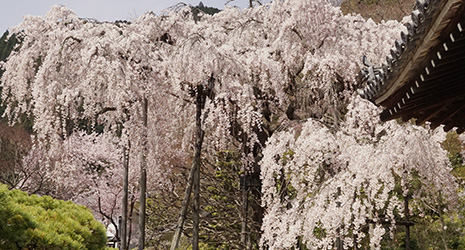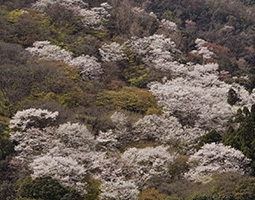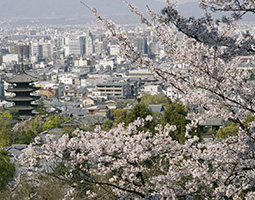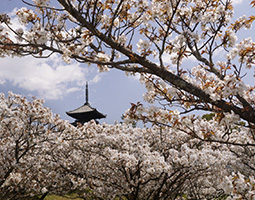INDEX
- English
- 日本語

The 300-year-old Shidare-zakura at Yoshimine Temple - English
- 日本語

Yaezakura at Nijo-jo Castle

Yamazakura in the Arashiyama district 
Yasaka Pagoda seen through Somei-yoshino 
Omuro Sakura at Ninna-ji Temple
April 2021
Cherry Blossoms Bring Spring Colors to Kyoto

Ancient Kyoto flourished as the capital of Japan for more than 1,000 years. The city is known for its picturesque scenery of many types of cherry blossoms, which bloom brilliantly for over a month. We asked photographer Hashimoto Kenji about Kyoto’s cherry blossoms.

Kyoto is suffused with the colors of cherry blossoms in spring and fall foliage in autumn. The people of Kyoto have long enjoyed cherry blossom viewing in the spring. Historically, in the early sixth century when the capital was in Nara, the aristocrats appreciated the sweet-scented plum blossoms. After the capital was relocated to Kyoto in 794, the flowers most adored in the spring gradually changed to cherry blossoms. By around the seventeenth century, cherry blossom viewing was enjoyed widely by the common people.
“I get excited every year when the cherry blossoms burst out in spring,” says photographer Hashimoto Kenji. Born and raised in Kyoto, Hashimoto has been taking photographs of the beautiful scenery of Kyoto for over forty years. He has a deep love and fascination for the delicate colors and grace of the cherry blossoms.

Currently, the vast majority of cherry trees in Japan are Somei-yoshino, a new variety created between the late eighteenth and early nineteenth centuries. The Somei-yoshino bloom between late March and late April on Honshu (the main island of Japan), and their blossoms fall in ten days to two weeks after blooming. However, the cherry blossoms in Kyoto are different in terms of the length of time that they can be enjoyed. In mid- to late March, the Shidare-zakura variety of cherry tree with their weeping branches bloom and then the Yamazakura, a wild species, start to flower. In April, the Somei-yoshino begin to bloom, followed by the vividly red Beni-shidare-zakura and finally the Yaezakura, which have multiple layers of petals. Every year, Kyoto is a showcase for the many cherry blossom species and varieties, which people can view for over a month.

Hashimoto has endeavored to express the beauty of the cherry blossoms that bloom amid the scenery of Kyoto. On the premises of the approximately 2,800 temples and shrines in Kyoto and the many other historic and scenic sites are cherry trees that add spring colors to the scenery, and many photogenic locations. Hashimoto has accumulated a wealth of knowledge about the best times and the type of weather conditions when each cherry tree looks its most beautiful.
Hashimoto says with a smile, “The appearance of cherry trees and how the flowers bloom change every year. There are young trees that will grow and older trees that will wither in the future. This is why I want to visit the same trees again and again.”

Among the many cherry trees in Kyoto, the one that Hashimoto finds to be the most beautifully formed is the 300-year-old Shidare-zakura in Yoshimine Temple in the mountains on the southwest edge of the city of Kyoto. This cherry tree that comes highly recommended by Hashimoto, who cherishes its blossoms through the viewfinder of his camera, will also change in the future. People are able to enjoy many kinds of cherry blossoms during Kyoto’s spring, spread across many nearby locations. This is one appeal of Kyoto.
COVID-19 has made it difficult for people to visit Kyoto. However, we are sure that many people around the world will enjoy the beauty of Kyoto’s cherry blossoms through photographs.

